IBM and Nvidia have established supercomputing Centers of Excellence at two of the most important research sites in the US: the Oak Ridge National Laboratory and the Lawrence Livermore National Laboratory.
This initiative will help support the construction of two GPU-accelerated supercomputers codenamed Summit and Sierra – set to be considerably faster than today’s most powerful computer system, China’s Tianhe-2.
Summit and Sierra will use IBM’s OpenPower processors, Nvidia’s Tesla GPUs and Mellanox’s InfiniBand interconnect. The Centers of Excellence will focus on software development and application code innovation.
Born in the USA
Oak Ridge and Lawrence Livermore laboratories are managed by the US Department of Energy (DoE). Both have world-class supercomputers: Oak Ridge is home to the world’s second most powerful supercomputer ranked by the Top500, Titan, while Lawrence Livermore has Sequoia (pictured right) – the world’s most powerful supercomputer in 2012, and still in third position on the Top500 list.
In November 2014, IBM announced it had been contracted to build new, more powerful machines for the DoE, at a cost of $325 million. Summit, being developed for Oak Ridge, will deliver 150 peak petaflops of performance to support research in fields like cosmology, astrophysics and biophysics.
One of its applications will focus on advancing Earth system models for climate research while another will map the planet’s interior by analyzing seismology research.
Sierra, destined for Lawrence Livermore, will deliver at least 100 peak petaflops to help tackle challenges in energy security and global warming. It will also ensure the safety and reliability of the US nuclear stockpile.
Both supercomputers will be completed by 2017 and are expected to become fully operational in 2018.
The Centers of Excellence will enable HPC researchers to develop software alongside the teams that build the hardware systems, so applications for Summit and Sierra can achieve the best performance by the time they are installed.
“Application code innovation is a vital component of making sure our facilities are prepared to take advantage of the performance of the new supercomputers,” said Michel McCoy, program director for Advanced Simulation and Computing at the Lawrence Livermore National Laboratory.
“By partnering with IBM and Nvidia, the Centers of Excellence bring together the people who know the science, the people who know the code, and the people who know the machines – ensuring we are innovating across the board so that Sierra and Summit will be primed to achieve their missions for national security and scientific advancement as soon as they’re delivered.”
Since research is being conducted under the OpenPower banner, technologies developed at the new Centers of Excellence could eventually be adopted in general purpose computing.
Last week, IBM, Nvidia and Mellanox launched a software design hub in Montpellier, France – similarly dedicated to the Power architecture and HPC applications.
Meanwhile HP and Intel have just announced a partnership around supercomputers based on the x86 architecture. As part of the arrangement, HP will expand its supercomputing Center of Excellence in Grenoble, and open a brand new facility in Houston, Texas - although no time frame was provided.

